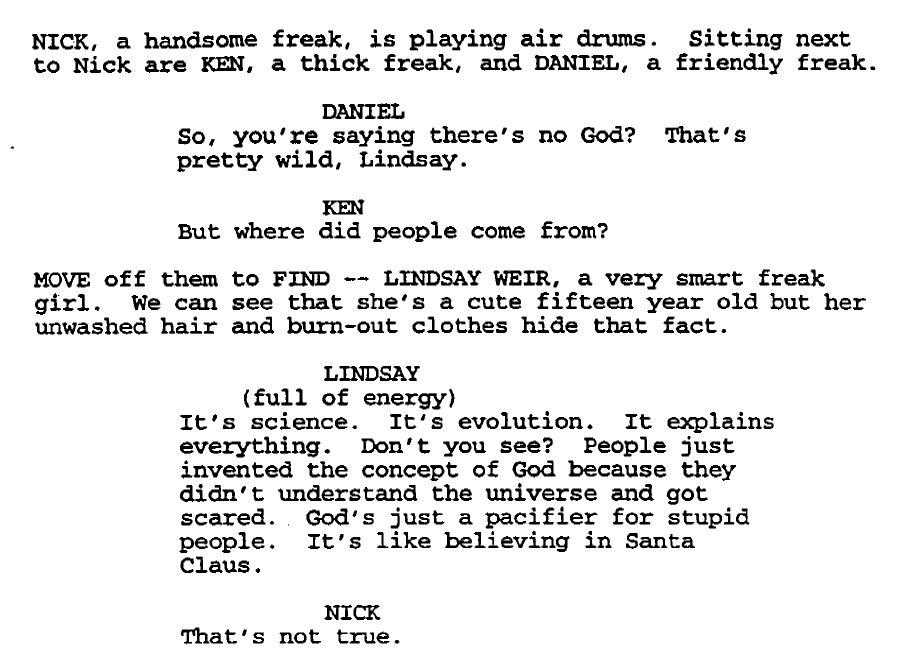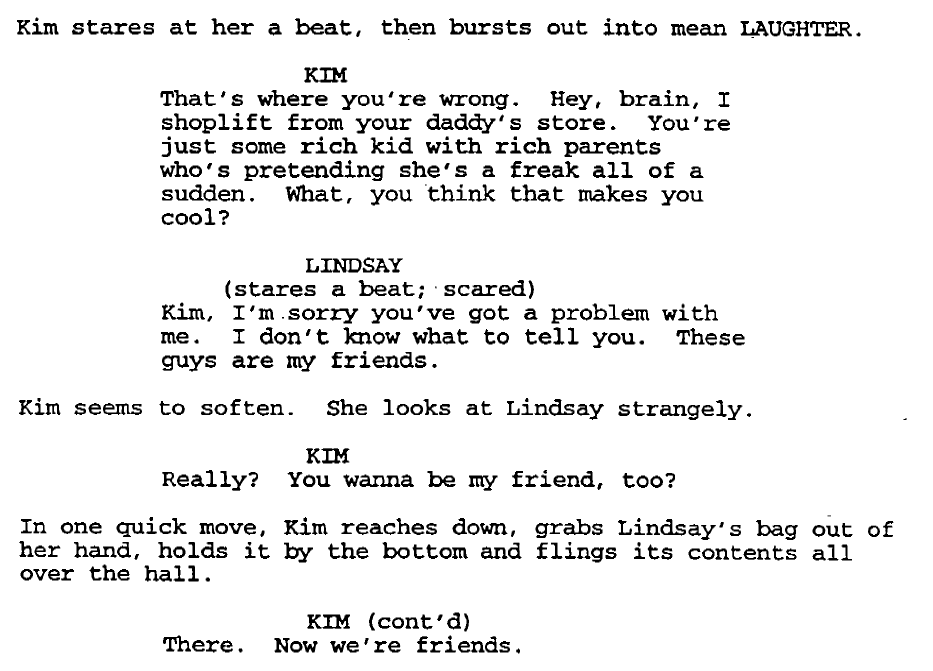Five Observations about FREAKS AND GEEKS
Happy Anniversary to Freaks and Geeks! The first episode, written by series creator Paul Feig, aired on NBC on September 25th, 1999. Just over twenty years later, the pilot script remains especially high on my list of recommended reading for patrons visiting the WGF Library.
Freaks and Geeks was a small and magical burst of television—like a song by Joan Jett & Blackhearts—short, raucous, but packed with emotion and entirely enduring… probably twenty years ahead of its time. If you’re a writer at any level in your career, you probably aspire to write something that really packs a wallop and sticks with people in the same way.
Well, I can’t tell you how to do that in a single blog post, but I can be a good script librarian by walking you through certain aspects of the pilot script. Here, we’ll look at a few spots where Mr. Feig pulls us in and makes us feel emotions.
Emotions, as you know, are the key to effective writing. Reading scripts and looking for where the writer particularly engrosses you is a great skill to cultivate in yourself.
In my view, the Freaks and Geeks pilot elicits feelings in two ways: 1) Through incredibly nuanced characters and 2) through warmly observed humor (which springs from its incredibly nuanced characters). Being a good writer means being able to lovingly capture the details of people. So, in celebration of the 20th Anniversary of this awesome TV show, let’s look at five instances where the pilot script does this. As I mentioned, being able to notice these techniques in other people’s scripts will make you more adept at using the same techniques in your own storytelling. Emotions are universal.
Pose an existential question and see how the characters react.
The second thing we see in this pilot is central characters debating the existence of God. The best stories get right to the big questions, and often, the best drama is created when two characters come down on opposing sides of such questions. If you want us to get to know your characters, have them debate something existential. This script is especially smart in how this isn’t just a one-off debate about the characters’ beliefs… but the very question of the afterlife comes back later when Lindsay and her brother Sam discuss their grandmother’s death. We all struggle with and debate questions like these. Posing tough questions to your characters is one of the most effective ways for us to get to know and empathize with them.
Also, I love the character descriptions here, neatly slipping everybody into the category of a “Freak” or a “Geek” or a “Jock.”
2. Ask: Are your characters more than how others categorize them?
When you search for its core, Freaks and Geeks is a show about how people are way more than the simple ways we try to define or categorize them. Here, right away, the brother is the victim of bullying and the sister is the tough one who defends him. Right away, Lindsay and Sam go against often-seen “types.” We empathize with Sam in his being threatened and pushed around, and we empathize with Lindsay and the heroic way in which she stands up for her brother.
3. Find the pain.
See this moment where Kim, a freak and a bully, mocks and taunts Lindsay for trying to be a part of the freak group. Her behavior is cruel, but we see hints of an inferiority complex, so we lean in to see what’s driving her. Sometimes we like to empathize with mean, aggressive characters. This is especially the case when we can see the pain behind their actions. In showing us that its characters are far more complex and multi-faceted than they seem on the surface, Freaks and Geeks works to find and reveal characters’ deep hurts underneath their veneers.
I think this is a good lesson. As pain is universal and something we can all relate to and understand, look for what’s hurting a character. If you want to draw us closer to someone in your story, look for their pain.
4. View every character as centrally important.
The best writing makes every character a memorable one, even if they only have one line. Take this moment as an example. As readers, we haven’t met or even seen Mr. Samek, but through the details Sam provides about him, we can see him in our minds. It’s vivid, and it makes Sam a more dynamic character because we see that he pays attention to the details about other people around him. We often think about film and television writing as being incredibly bare-bones and economical, but don’t forget to pay attention to character details because it’s details that pull us in.
5. Remember: Everybody loves an underdog.
We love an underdog who stands up for themselves and others against overwhelming odds. I can’t speak for you, but in our current climate where impassivity and even cruelty towards others is so conspicuous, these are the types of stories and characters I crave: Underdogs who’ll risk their life for to protect their close friends. Plus, I just love the way Bill Haverchuck sees the world and expresses himself.
If you decide to read the Freaks and Geeks pilot for its 20th Anniversary, plum the big questions, the details, the pain embedded in it. I think to bring out these qualities in your own writing, you needn’t ram your head against a wall trying to “cook up” specificity and minutia. Rather, just ask yourself why you love this character or strongly dislike that one. It’s when you look at how you feel about someone or something that the poignant particulars begin to emerge.
Thank you Freaks and Geeks and Paul Feig for showing us this.
You can read all 18 episodes of this show as well as many, many other film and television scripts in our library. Search the catalog here.





